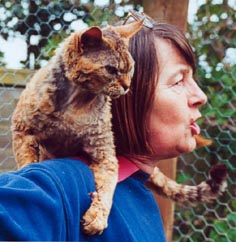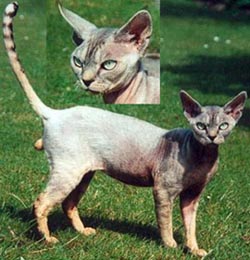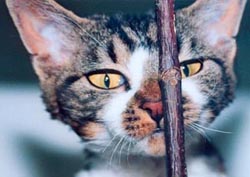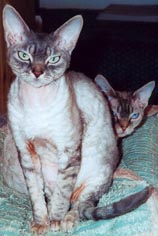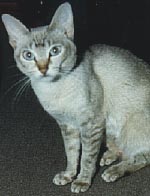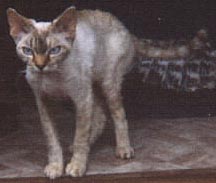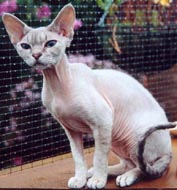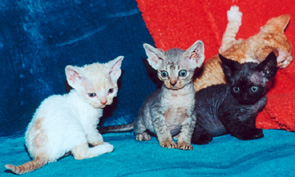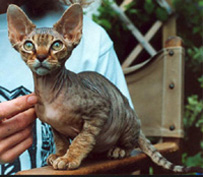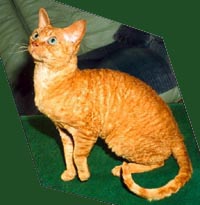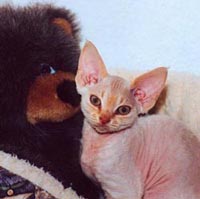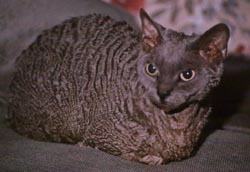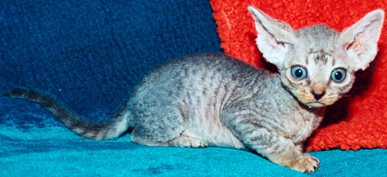|
|
Devon Rex
|
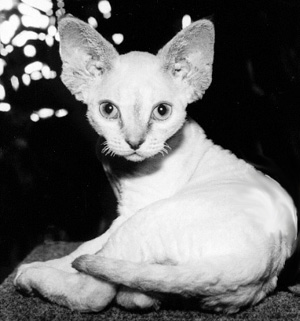 |
|||||||||||||||||||||||||
an irrepressible character, a curly coat and the cheek of the devil? A Devon Rex of course. The imp of the cat world. |
||||||||||||||||||||||||||
The Devon Rex |
||||||||||||||||||||||||||
|
||||||||||||||||||||||||||
CharacterDevons are - inquisitive, friendly, fun loving, chatty, sociable cats who will help and hinder, with tail busily wagging. They generally eat all and everything! A Devon will ride on your shoulder, wrap around your neck, coorie into the crook of your arm or join you in your jersey. The Devon loves to sit with its face millimetres from your own: literally an in-your-face cat. Having said that, they have their (very) independent moments too. These are very lively characters and into everything; at times they are utterly exasperating! |
||||||||||||||||||||||||||
|
||||||||||||||||||||||||||
|
||||||||||||||||||||||||||
Origin and breed developmentAround 1960, a disused tin mine in Devon was frequented by a curly coated tom. In a litter he sired to a normal coated feral cat was a curly coated kitten. It is this kitten, Kirlee who is the forerunner of all Devon Rexes worldwide. It took a lot of outcrossing to develop the Devon Rex breed from this one cat. As the gene pool is still so small, many breeders continue to outcross to other breeds (not the Cornish Rex which is a different mutation). The first generation kittens from such a mating are ‘normal’ straight coated cats. This is because the rex gene is recessive to the normal coat gene. These straight coated kittens are known as Devon Rex variants and they ‘carry’ the rex gene. When these first generation (F1) variants are mated back to a Devon Rex, half the kittens born will be Devon Rexes, often with very good coats. |
||||||||||||||||||||||||||
|
||||||||||||||||||||||||||
|
||||||||||||||||||||||||||
|
||||||||||||||||||||||||||
CareDespite their short, occasionally almost non-existent coats and their passion for cosy places, the Devon Rex is a healthy, hardy breed and does not need any special care other than the standard common sense care given to any short coated feline. AppearanceA short, wedge-shaped head, full cheeks and a strong chin; ears which are large, low-set and wide apart; eyes which are oval in shape and wide set; these are features which combine to give the Devon its typically pixie face. In profile the nose should show a stop with the forehead curving back to a flat skull. The body should be hard and muscular, but slender, with long slim legs, a broad chest and a slender neck. The coat is short and soft, wavy or curly. The underparts may be well-coated or covered in down. Whiskers and eyebrows can be crinkled; quite frequently they are missing, since they are brittle and can easily break or be chewed off. Devon Rexes come in a kaleidoscope of colours: black, white, blue, red, cream, chocolate, lilac, caramel - the list goes on. There are a whole range of patterns too: self-coloured, smokes (with a lighter undercoat), tabbies, torties, bi-colours, tri-colours and pointed. The pointed cats can be Siamese pointed (si-rex), which are white/pale bodied with colour on face, feet and tail and with blue eyes. Or they can be pointed as in the Tonkinese. Here, the colour on the body shades to a darker colour on the face, feet and tail. These Darker Points have pale blue-green eyes. |
||||||||||||||||||||||||||
|
||||||||||||||||||||||||||
|
||||||||||||||||||||||||||
|
||||||||||||||||||||||||||
|
||||||||||||||||||||||||||
More about the Devon Rex coatThe rexed coat is an important characteristic and bareness is a fault. That said, coats in Devons are very variable and kittens in particular can be excused for being somewhat lacking in the coat department. Rexing can range from loose waves to fine curls to deeply rippled waves. Some cats are completely coated, while others are scantily clad on the underparts and around the neck and chest. In many cases, Devons are born with a rexed coat but lose it at the age of a few days to a few weeks, gradually growing it in again over the next few months. Some may remain in the suede phase until the age of 2 to 4 years of age, and then they can be splendid. There are those who are perpetual ‘fur points’. On the other hand a kitten can be born fully coated and keep that coat throughout its life. Although a breeder may have a good idea of how a coat is going to develop, it is never a certainty! |
||||||||||||||||||||||||||
|
||||||||||||||||||||||||||
|
||||||||||||||||||||||||||
|
||||||||||||||||||||||||||
Allergies and RexesRexes are often recommended as being suitable for people with allergies. This is not necessarily so. Rex cats may suit some people with allergies if the allergy is to the guard hairs. They will not suit people who are allergic to cat saliva or dander. The only way to find out is to try. Find a Rex-only house (we can help) and stay at least 1 hour with Rexes all over you - rub eyes and mouth while there. Go home and see how you are over the next few hours. If no reaction then fine - go ahead. If you had a mild reaction go back and repeat the visit a few days later. A few people with mild allergy take antihistamine when they are bad. Having asthma does not automatically rule out cat ownership but much thought is required. Regular bathing or wiping the cat with damp cloth or hands may also help. Keep your bedroom strictly a cat free zone, at least in the beginning. While any good breeder would take back a cat/kitten of their breeding it is not fair to the cat/kitten to get it and have to return it if it does not work...... |
||||||||||||||||||||||||||
|
||||||||||||||||||||||||||
This breed profile was put together by Elizabeth Brown (Cherek), with the much appreciated help of other SRCC members Alex Carrick, Sandra & Morag Brown, Kate Ekanger (Cloudborn), Anne Ross (Tamorie) and Wendy & John Soper (Sangeorge) in the form of text, photos and criticism. |
||||||||||||||||||||||||||
|
© Scottish Rex Cat Club 2002 The material that appears on this site is the property of the SRCC and contributors. None of it is to be published elsewhere without permission of the copyright-holders. |
